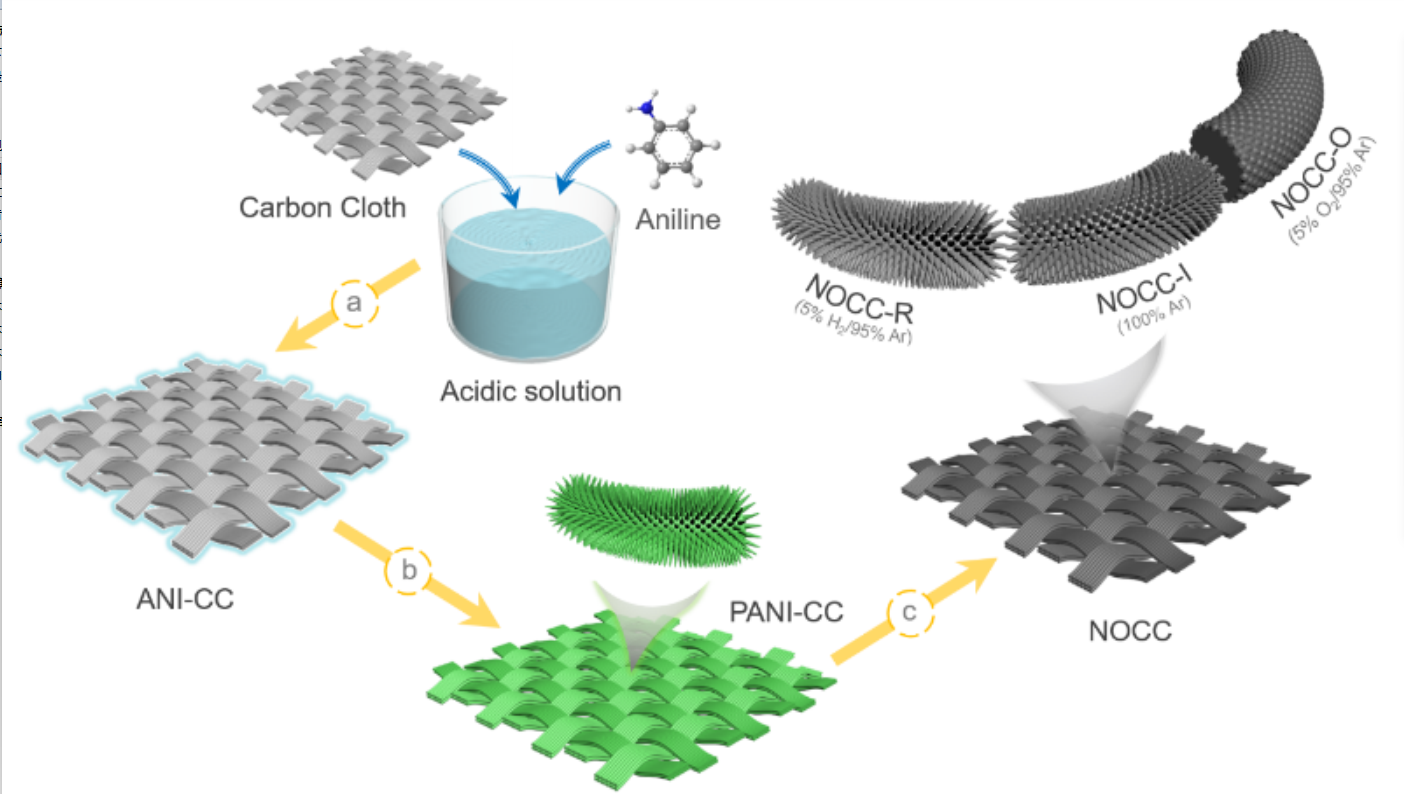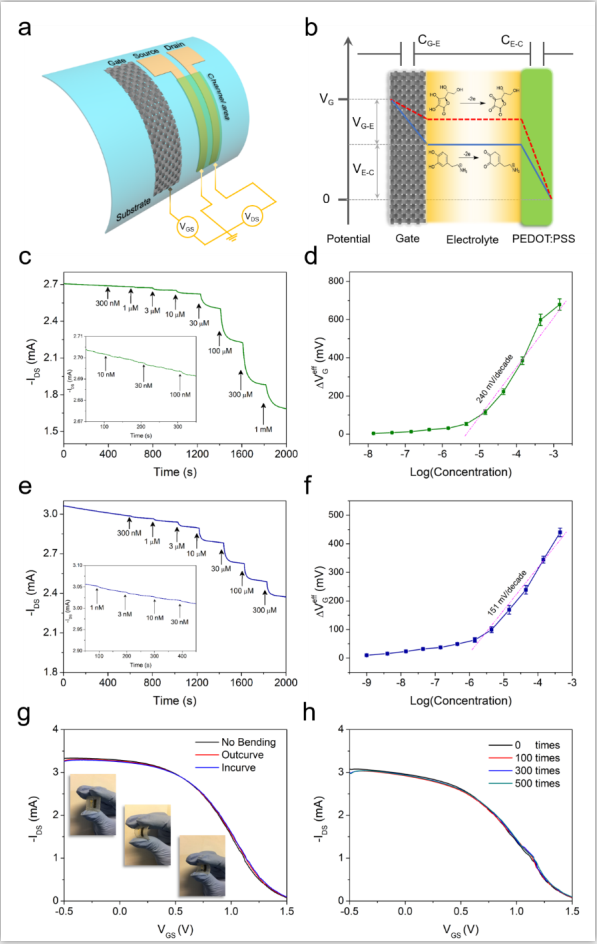Prof. Ruili Liu’s Research Team Made Breakthrough in the Fabrication of OECT-based Biosensors
Date: 12 November 2019
On October 25, the research team led by Associate Professor Ruili Liu from Center for Opto-Electronic Materials and Devices in EE Department has published the research work online in Advanced Functional Materials, which is a top-tier materials science journal. The title of the research paper is “Manipulating the Sensitivity and Selectivity of OECT-Based Biosensors via the Surface Engineering of Carbon Cloth Gate Electrodes”.
In this work, the effective adjustment of carbon fiber surface components by surface engineering is combined with the electromechanical chemical transistor device (OECT). Moreover, OECTs also provide the opportunity to fabricate flexible biosensors with high sensitivity. However, there are currently very few methods to improve the selectivity of OECT sensors. Therefore, nitrogen/oxygen-codoped carbon cloths (NOCCs) are prepared by the carbonization of polyaniline-wrapped carbon cloths at 750 °C under different atmospheres. The resulting NOCC electrodes exhibit different electrochemical sensing behaviors toward ascorbic acid (AA) and dopamine (DA), enabling the fabrication of OECT sensors with high sensitivity and selectivity that are comparable to the state-of-the-art OECT sensors for AA and DA. The structural characterization and theoretical calculation reveal that the electrochemical sensing behaviors of the NOCC electrodes are closely related to their surface compositions, providing an unprecedented strategy for the design of flexible OECT sensors with high sensitivity and selectivity.
This work was completed in cooperation with Professor Xiaojun Guo, from Laboratory of Printed electronics and Flexible Integration, and Associate Professor Dongqing Wu, in School of chemistry and chemical engineering.
The first author is Doctoral candidate Xin Xi, in the Department of Electronic Engineering. The co-corresponding authors are Associate Professor Dongqing Wu, Professor Xiaojun Guo and Associate Professor Ruili Liu.

With the rapid development of wearable electronics, flexible biosensors have received intensive attention since they can provide the opportunity to monitor the real-time biological and medical information of the wearer. In addition to flexibility, biosensors in wearable electronics also need high sensitivity and selectivity, because the analytes in body fluids such as ascorbic acid (AA), dopamine (DA), and uric acid (UA) are usually combined together in very low concentrations (× 10−6 or × 10−9 M level). In this respect, organic electrochemical transistors (OECTs) offer an appealing solution for the construction of highly sensitive flexible biosensors. Because, the transistor configuration of the OECT helps to magnify the signals from analytes with low concentrations, thus effectively improving the limits of detection (LOD). Moreover, OECTs are easily constructed on flexible substrates, since the electroactive semiconductors in OECTs are organic species, which also provides advantages to OECT-based biosensors, including high biocompatibility and a low operating voltage.
Due to the enhanced sensitivity, the selectivity of OECTs toward analytes with similar redox potentials is crucial for their practical applications. To improve the selectivity of OECT-based biosensors, one common strategy is to deposit electronegative polymers such as chitosan and perfluorinated sulfonic acid on their gate electrodes, which can effectively prevent the electron-rich analytes from having access to the surface of the electrodes. However, the polymers used for the electrode modification may cause interface resistance between the polymers and gate electrodes, which will then reduce the sensitivity of the OECT. On the other hand, the gate electrodes of OECT sensors consist mainly of gold or platinum. The negative impacts of these precious metals on the OECTs are not merely the increased costs. More importantly, the precious metal gate electrodes may lose their electrocatalytic abilities due to poisoning by sulfur, chlorine, phosphorus, and other substances, which inevitably harms the stability and reproducibility of the OECT sensors. Therefore, the fabrication of gate electrodes for flexible OECTs with both high sensitivity and high selectivity remains a challenge.

Compared with precious metals, carbon materials have obvious advantages, including natural abundance, low fabrication cost, chemical stability and mechanical flexibility. Even more intriguing, the electrocatalytic activity, conductivity and electrolyte affinity of carbon materials can all be judiciously adjusted by the replacement of carbon atoms on their surfaces with heteroatoms such as nitrogen (N), oxygen (O), and sulfur (S). Therefore, the surface engineering of carbon materials with heteroatoms provides alternative methodologies for the design of unconventional carbonaceous gate electrodes for OECTs with high sensitivity and selectivity.
Liu’s team demonstrates the fabrication of N/O-codoped carbon cloths (NOCCs) as the gate electrodes in flexible OECT sensors with different sensitivities and selectivities. The NOCC electrodes are prepared by the carbonization of polyanilinewrapped carbon cloths at 750 °C, and the amounts and species of N and O atoms on their surfaces can be easily tuned by changing the atmosphere (oxidative, inert, or reductive) during the carbonization process. In a three-electrode electrochemical sensing system, the NOCC electrode obtained under reductive conditions exhibits higher sensitivity toward AA than DA, while the NOCC electrode from the oxidative atmosphere has a better selectivity for the detection of DA. More importantly, the different sensing capabilities of the NOCC electrodes are acquired by the OECTs when the NOCC electrodes are used as the gate electrodes, thus enabling the fabrication of OECT sensors with excellent sensitivity and selectivity toward AA and DA. As verified by the experimental results and theoretical calculations, the surface engineering of carbonaceous gate electrodes by modifying the heteroatoms on their surfaces provides an efficient strategy for the design and construction of high-performance OECT biosensors.

This work was financially supported by the National Natural Science Foundation of China (61575121, 51772189, 21720102002, 21772120, and 21572132) and Science and Technology Commission of Shanghai Municipality (16JC1400703).
About Introduction to Advanced Functional Materials
Firmly established as a top-tier materials science journal, Advanced Functional Materials reports breakthrough research in all aspects of materials science, including nanotechnology, chemistry, physics, and biology. The 2018 Journal Impact Factor for Advanced Functional Materials is 15.621 (Journal Citation Reports (Clarivate Analytics, 2019)).
Click "Link" to view the full paper
Link: https://onlinelibrary.wiley.com/doi/10.1002/adfm.201905361